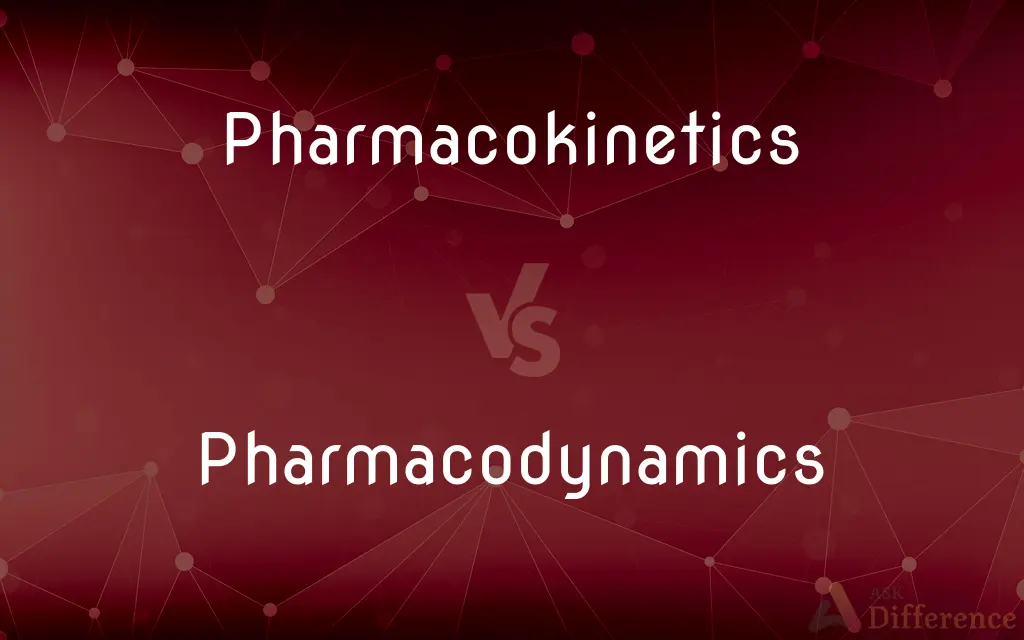Pharmacokinetics vs. Pharmacodynamics — What's the Difference?
By Tayyaba Rehman & Urooj Arif — Updated on March 15, 2024
Pharmacokinetics describes how the body processes a drug, while pharmacodynamics focuses on how the drug affects the body.

Difference Between Pharmacokinetics and Pharmacodynamics
Table of Contents
ADVERTISEMENT
Key Differences
Pharmacokinetics (PK) is the branch of pharmacology concerned with the movement of drugs within the body, covering absorption, distribution, metabolism, and excretion (ADME). It answers the question, "What does the body do to the drug?" by examining how drugs are absorbed to distributed to tissues, metabolized into active or inactive forms, and finally excreted. Pharmacodynamics (PD), on the other hand, delves into the biological and physiological effects of drugs on the body and their mechanisms of action. It addresses the question, "What does the drug do to the body?" This includes how a drug exerts its therapeutic effect, the relationship between drug concentration and effect, and the concept of drug-receptor interactions.
This field of pharmacokinetics is crucial for understanding the onset, duration, and intensity of a drug's effect, as well as its bioavailability and half-life. Pharmacodynamics is essential for understanding the dose-response relationship, which helps in determining the appropriate dosage of a drug to achieve the desired therapeutic effect without causing adverse effects.
While pharmacokinetics provides insights into the drug's journey through the body, pharmacodynamics offers an understanding of the drug's biological effects and its efficacy. Together, these disciplines ensure the safe and effective use of pharmaceuticals by optimizing dosing regimens and minimizing adverse effects.
The study of pharmacokinetics involves various parameters such as absorption rates, bioavailability, volume of distribution, clearance, and half-life. These parameters help in predicting the concentration of a drug over time, which is crucial for determining dosing schedules and ensuring consistent therapeutic levels are maintained.
Pharmacodynamics involves the study of the therapeutic window, receptor binding affinity, and intrinsic activity of drugs. Understanding these aspects is vital for designing drugs that can selectively target specific receptors or biological pathways, thereby maximizing therapeutic benefits while minimizing the risk of side effects.
ADVERTISEMENT
Comparison Chart
Focus
How the body processes a drug
How the drug affects the body
Key Areas
Absorption, Distribution, Metabolism, Excretion (ADME)
Drug-receptor interactions, Dose-response relationship
Main Question
What does the body do to the drug?
What does the drug do to the body?
Parameters Studied
Bioavailability, Volume of distribution, Clearance, Half-life
Therapeutic window, Receptor binding affinity, Intrinsic activity
Importance
Determines onset, duration, and intensity of drug effect
Determines efficacy, therapeutic effect, and potential side effects
Compare with Definitions
Pharmacokinetics
Absorption.
The drug's absorption rate determines how quickly it reaches the body after oral administration.
Pharmacodynamics
Efficacy.
The drug's efficacy is its ability to produce a maximum response.
Pharmacokinetics
Bioavailability.
Intravenous administration offers 100% bioavailability, ensuring the drug acts more rapidly.
Pharmacodynamics
Drug-receptor interaction.
The drug binds to cellular receptors, triggering a physiological response.
Pharmacokinetics
Distribution.
The wide distribution of the drug across different tissues can influence its therapeutic effects.
Pharmacodynamics
Dose-response relationship.
Increasing the dose of the drug enhances its therapeutic effect up to a certain point.
Pharmacokinetics
Metabolism.
Liver enzymes metabolize the drug into active or inactive metabolites.
Pharmacodynamics
Side effects.
Understanding pharmacodynamics helps in predicting potential side effects of drugs.
Pharmacokinetics
Excretion.
The drug is eventually excreted through the kidneys or bile.
Pharmacodynamics
Therapeutic window.
The drug's therapeutic window defines the range between its effective dose and toxic dose.
Pharmacokinetics
The process by which a drug is absorbed, distributed, metabolized, and eliminated by the body.
Pharmacodynamics
The study of the action or effects of drugs on living organisms.
Pharmacokinetics
Pharmacokinetics (from Ancient Greek pharmakon "drug" and kinetikos "moving, putting in motion"; see chemical kinetics), sometimes abbreviated as PK, is a branch of pharmacology dedicated to determine the fate of substances administered to a living organism. The substances of interest include any chemical xenobiotic such as: pharmaceutical drugs, pesticides, food additives, cosmetics, etc.
Pharmacodynamics
Pharmacodynamics (PD) is the study of the biochemical and physiologic effects of drugs (especially pharmaceutical drugs). The effects can include those manifested within animals (including humans), microorganisms, or combinations of organisms (for example, infection).
Pharmacokinetics
The study of this process.
Pharmacodynamics
(pharmacology) The branch of pharmacology that studies the effects and modes of action of drugs upon the body.
Pharmacokinetics
(pharmacology) A branch of pharmacology concerned with the rate at which drugs are absorbed, distributed, metabolized, and eliminated by the body.
Pharmacokinetics
(pharmacology) The particular rates at which drugs are absorbed, distributed, metabolized, and eliminated by the body.
Pharmacokinetics
The study of the action of drugs in the body: method and rate of excretion; duration of effect; etc.
Common Curiosities
What is the main difference between pharmacokinetics and pharmacodynamics?
Pharmacokinetics deals with the drug's movement through the body, while pharmacodynamics focuses on the drug's effect on the body.
Why is the study of pharmacokinetics important?
It helps in determining the appropriate dosing, timing, and route of administration for drugs to ensure they are safe and effective.
What role does metabolism play in pharmacokinetics?
Metabolism transforms drugs into active or inactive compounds, affecting their efficacy and duration of action.
What factors can affect a drug's pharmacodynamics?
Factors include the drug's concentration, the presence of other drugs, and the individual's physiological condition.
How is bioavailability measured in pharmacokinetics?
It is measured as the fraction of an administered dose that reaches the systemic circulation in an active form.
What is clearance in pharmacokinetics?
Clearance refers to the rate at which a drug is removed from the body.
Why is the dose-response relationship important in pharmacodynamics?
It helps in determining the optimal dose that produces the desired effect without causing adverse effects.
How does pharmacodynamics influence drug therapy?
It aids in understanding how drugs exert their therapeutic effects, allowing for the optimization of drug design and dosing regimens.
How do drug-receptor interactions relate to pharmacodynamics?
They are central to understanding how drugs exert their effects by binding to specific receptors in the body.
What is meant by a drug's therapeutic window?
It is the range of drug concentrations that provides efficacy without causing toxicity.
Can a drug have different pharmacokinetic profiles in different individuals?
Yes, due to variations in metabolism, age, genetic factors, and health conditions.
How do pharmacokinetics and pharmacodynamics interact?
The concentration of a drug in the body (pharmacokinetics) influences its effect on the body (pharmacodynamics).
Can pharmacokinetics change over time for a patient?
Yes, due to factors like age, disease progression, and interactions with other drugs.
How is the volume of distribution used in pharmacokinetics?
It indicates how extensively a drug disperses throughout the body's compartments.
What is intrinsic activity in pharmacodynamics?
It refers to the ability of a drug-bound receptor to initiate a physiological response.
Share Your Discovery

Previous Comparison
Dynein vs. Kinesin
Next Comparison
Dam vs. ReservoirAuthor Spotlight
Written by
Tayyaba RehmanTayyaba Rehman is a distinguished writer, currently serving as a primary contributor to askdifference.com. As a researcher in semantics and etymology, Tayyaba's passion for the complexity of languages and their distinctions has found a perfect home on the platform. Tayyaba delves into the intricacies of language, distinguishing between commonly confused words and phrases, thereby providing clarity for readers worldwide.
Co-written by
Urooj ArifUrooj is a skilled content writer at Ask Difference, known for her exceptional ability to simplify complex topics into engaging and informative content. With a passion for research and a flair for clear, concise writing, she consistently delivers articles that resonate with our diverse audience.















































